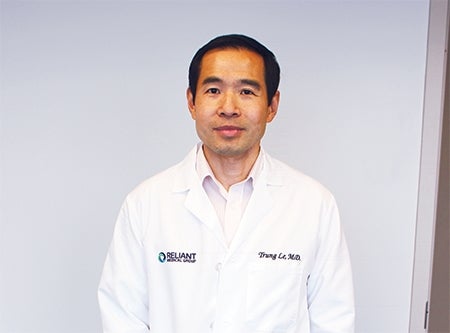Dr. Trung Le has seen a remarkable transformation in cosmetic surgery over his 13-year career, with less invasive procedures becoming more common. A plastic surgeon at Reliant Medical Group, located inside Saint Vincent Hospital in Worcester, Le talked about the cosmetic and reconstructive work he does, and why plastic surgery has lost its stigma in a recent interview with Central Massachusetts HEALTH.
Why did you choose to specialize in plastic surgery?
I was in my third year at SUNY Medical School in Brooklyn. We saw a big trauma case. Because of the nature of the trauma, the plastic surgery team was called in. The plastic surgeon worked half the night to reconstruct a man’s face. I saw that and thought I’d be good at it.
Are there misconceptions you encounter as a plastic surgeon?
A lot of people think that plastic surgery just involves the cosmetic side but that’s certainly not true at all. It started out to help soldiers on the battlefield, to restore function to the injured. I try find a balance between the two by doing both reconstructive and cosmetic plastic surgery.
What procedures do you perform the most? Has it changed over time?
On the reconstructive side, I do a lot of reconstruction after skin cancer incisions; breast reconstruction after cancer and droopy eyelids, which impact the visual field. On the cosmetic side, it’s botox; fillers; body contouring; facelifts; and removing excess skin from upper and lower lids. We’ve been doing a lot more fat grafting lately. For patients who have contour defect in one part of their body, we can borrow fat from another part of the body to reconstruct it. This can be cosmetic, but fat grafting can be used for reconstructive surgery too, for example, in breast reconstruction.
What about insurance coverage?
I try to be upfront with patients and tell them a procedure is probably cosmetic and won’t be covered by insurance. But there are gray areas. A patient may lose 100 lbs and he or she may have a lot of excess tissue. Removing it may be covered by insurance; it depends on the functional deficits that they have. We try to get them seen by other doctors. For example, someone with a lot of loose tissue on the abdomen we might send to a dermatologist for treatment with cream or antibiotics. Leaving that paper trail increases the chances it will get approved.
Is there a stigma around plastic surgery?
I graduated in 2004 and since then I have not noticed much of a stigma.. I have patients who come to see me after doing surgery and they have no compunction about showing family or friends the work they’ve had done. It may have been true years ago but now I don’t think so. It’s reflected in popular culture. You have these plastic surgery reality shows so I think the stigma has really gone away. And rightly so. I don’t think it’s anything to keep hidden away. I think maybe social media has contributed to this too. We share so much about our personal life online. Patients definitely aren’t coy about it anymore.
How has the field changed during your career?
There’s been a shift from invasive to non-invasive cosmetic surgery. Before the tool the cosmetic surgeon had was a facelift. We have so many more tools at our disposal now — botox, fillers, lasers — all this can be done long before a patient needs a facelift and the research shows they’re safe and effective. Changes in reconstructive surgery are not as pronounced. There have also been advances in stem cell research. As plastic surgeons we do a lot of skin grafts. Imagine if we could grow skin; that would revolutionize burn surgery.
What is the best part of your job?
It’s cliche, but I do feel like we help people and there’s satisfaction in seeing the results right away. After a breast lift, you see the result right there. A man with droopy eyelids who can’t see, he tells me he can see now. The results are pretty much instantaneous, and I like that. That’s probably why I didn’t go into internal medicine.
– This interview was conducted and edited for length and clarity by Emily Micucci.

